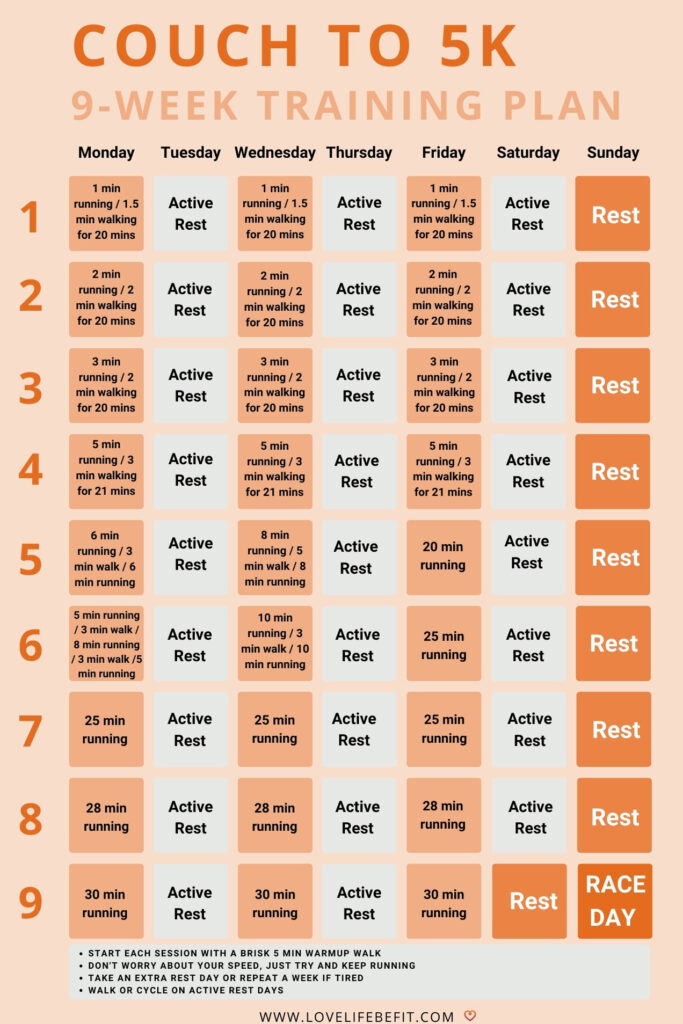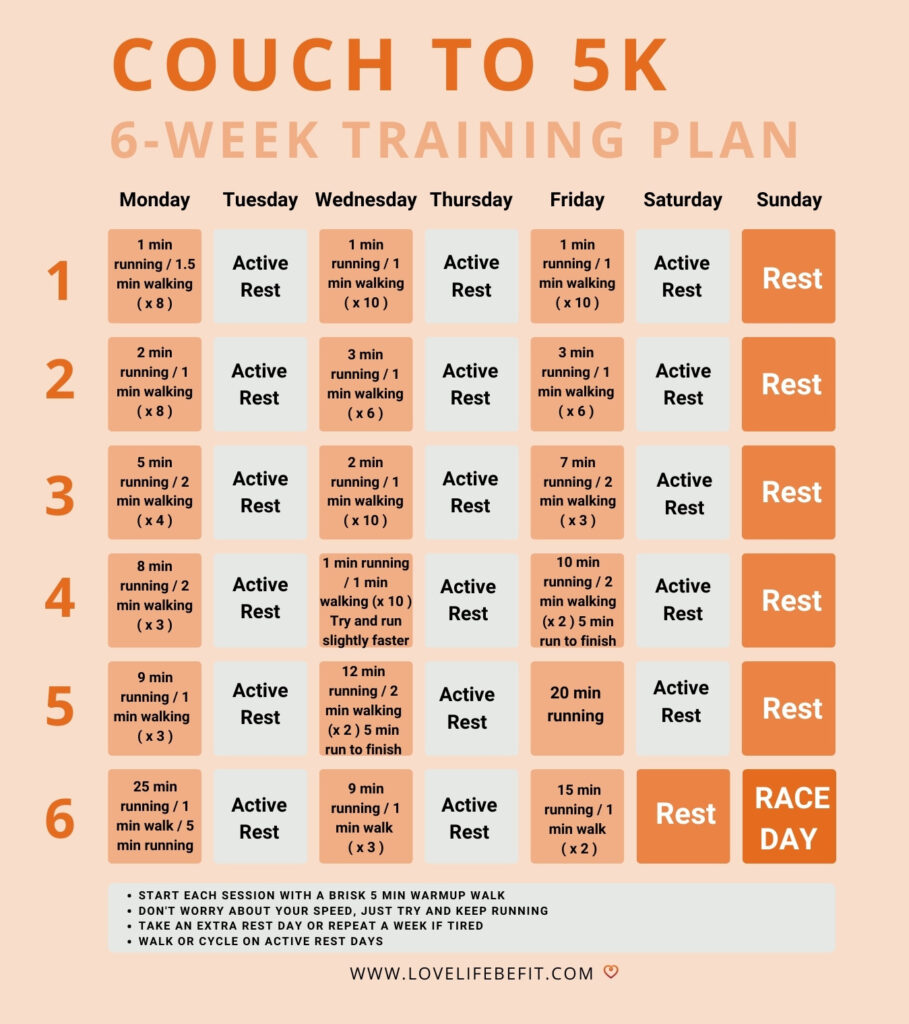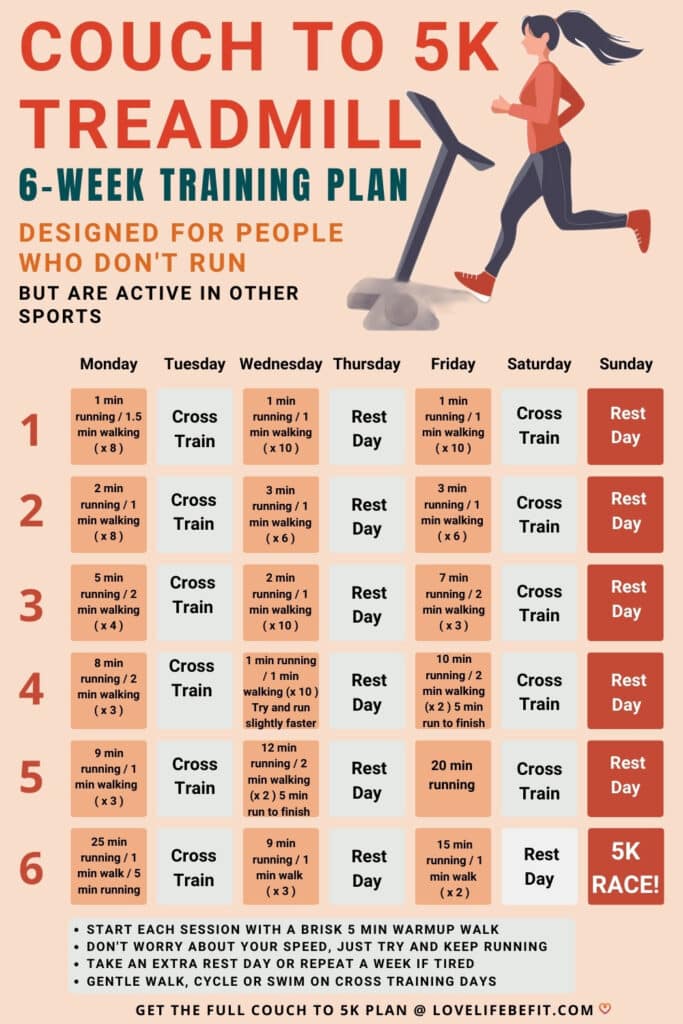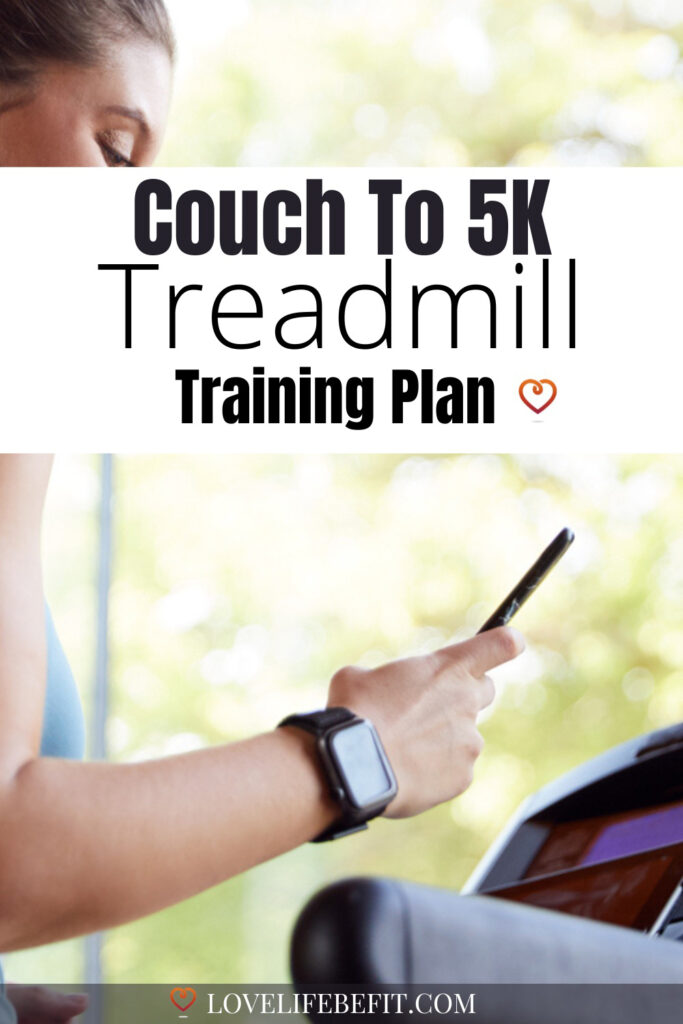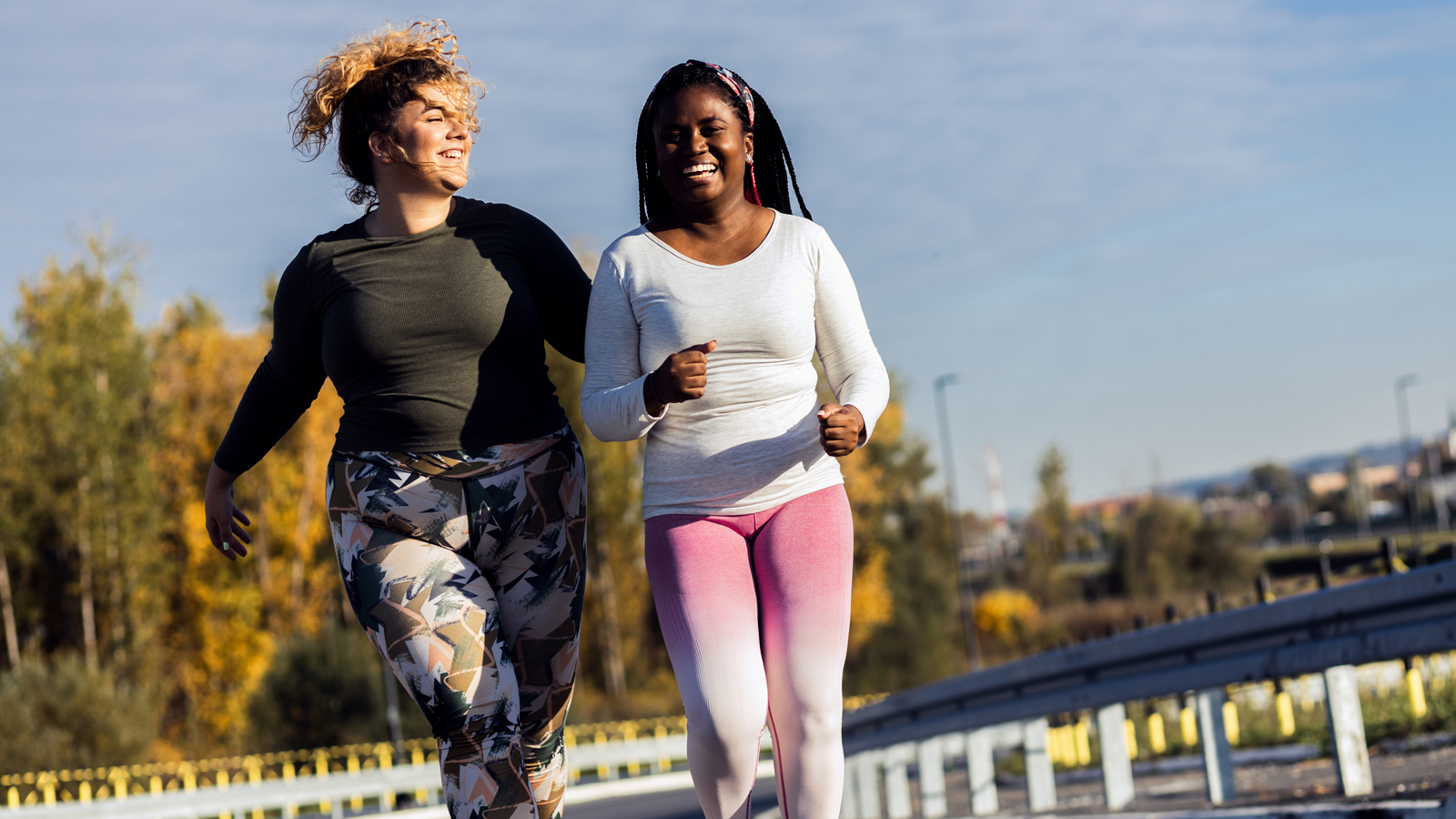Couch To 5K Treadmill Plan + Training Guide
Dark nights and slippery icy surfaces all conspire to stop you from running outside. So what’s the alternative? You can avoid running outside with this Couch to 5K treadmill training plan.
There’s no reason Couch to 5K can’t be completed in the warmth and safety of your own home, or even your local gym. You just need to follow the tips in this guide to get started.

Couch To 5K Treadmill 9-Week Training Plan
This is based on the original Couch to 5K running plan by Josh Clark with a few adjustments.
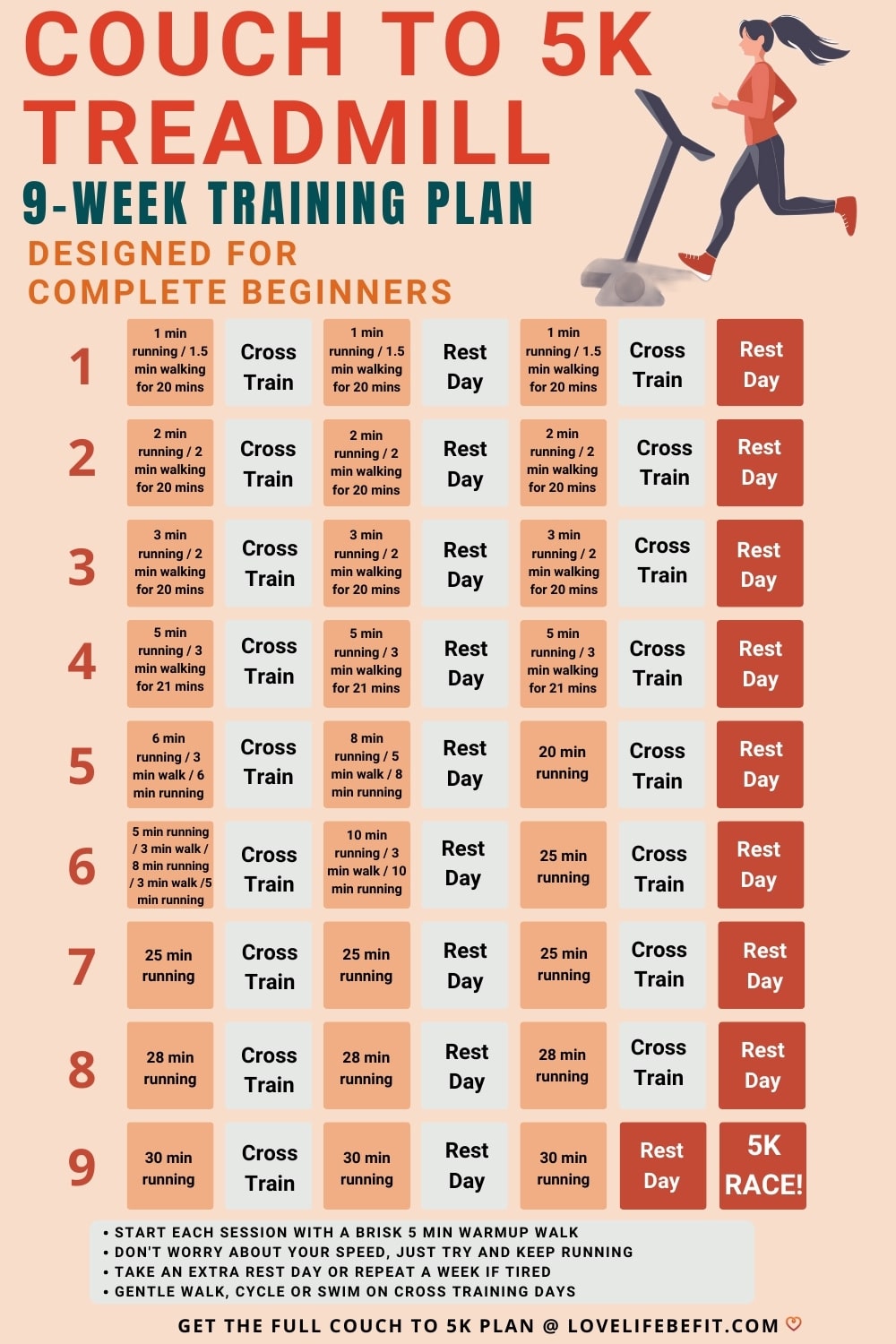
Does Couch To 5K Work On A Treadmill?
I used to think running on a treadmill was as much fun as watching paint dry. But that was years ago living in a hot country where I ran on a treadmill because the temperature was 40°C plus outside (104° Fahrenheit).
It was in the pre-internet dark ages and treadmills were really basic. They didn’t have fancy TVs or any distractions from the monotony of running in a straight line going nowhere.
But times have changed and treadmills are a lot more sophisticated nowadays. So much so that many runners today prefer to train on them rather than pounding the pavement.
Here are some of the benefits of running Couch to 5K on a treadmill over running outdoors:
The Benefits Of Doing C25K On A Treadmill
#1 Weather Conditions
I love running. I’d rather be running than doing just about anything else. But on dark winter days, I can still talk myself out of venturing outdoors – especially if it’s raining heavily.
It doesn’t rain, sleet or snow in the comfort of your home or gym. With the treadmill, there are no weather-related excuses for skipping training sessions.
#2 Safety
There’s less stress running in the safety of your home or local gym. This isn’t just important for women – road running on dark nights is a hazard for everyone. You can mitigate the risks by wearing hi-viz clothing but it’s easy to see why some runners, especially beginners, prefer to run indoors.
Instead of worrying about traffic or running in the dark on your own, take your running indoors and train in a safe running space.
#3 Pacing
Most new runners struggle to know how fast to run. With a treadmill, you can pre-determine your running pace.
There’s no risk of setting off too fast or slowing down when you feel a bit tired. You have to make a conscious effort to slow down or speed up on a treadmill – and that really helps when you’re learning to pace yourself.
Instead of guessing your pace or constantly checking your watch, the treadmill belt sticks to a constant speed.
#4 Less Impact
Running on pavements and roads is a high-impact activity and can be hard on your joints and body, especially when you’re new to running.
Using a treadmill lessens that impact and will reduce the risk of injury. Of course, you can still overtrain or try and run too fast for your fitness level, but using a treadmill reduces the impact forces.
#5 Avoiding Boredom
Running on a treadmill used to be boring – but not anymore! Catch up on the latest TV soaps, listen to podcasts, or your favorite playlist. With your mind distracted, your treadmill workouts will be over in no time at all.
You can even convince yourself you’re running somewhere new and exciting! Modern treadmills come with virtual running routes. One day you could be running on Kodiak Island, Alaska, and the next along Cocoa Beach, Florida. The possibilities are endless…

How Should A Beginner Run A 5K On A Treadmill?
Most of the advice for new runners applies just as much to treadmill running. Warm up, cool down, and don’t do too much too soon… but there are a few treadmill-specific tips to take on board before you start running.
Treadmill Running Shoes
Just because you’re running on a treadmill, don’t skimp on your running shoes. On a treadmill, you’re trying to simulate running on roads so most road running shoes are suitable for running indoors.
But you don’t need as much cushioning or grip as you’re not getting the same impact or running on slippery surfaces. Instead, you need shoes that will give you a good energy return when you’re running on the treadmill belt.
Look for lightweight, breathable shoes with good support. You’ll need adequate cushioning but not ultra-soft shoes that will dampen your motion.
Learn How Your Treadmill Works
It’s best to figure out how your treadmill works before you start your exercise program. There’s nothing worse than needing to slow down (or speed up) partway through a workout and not knowing which buttons to press.
With most modern treadmills you can pre-set your workout including the pace and walk breaks, so all you’ll have to do is press go when you start your workout session.
Get familiar with the display and check how to adjust the speed or pace and the incline. Often the controls are on the display monitor and on the handrails. Practice with the controls before you get started.
Set The Incline
It’s a good idea to set a slight incline when you’re running on a treadmill. This is a great way to mimic the uneven surface of running outdoors. Start with a 1-3% incline. Experienced runners may want to set the incline higher for a harder workout.
Get Your Balance
Running on a treadmill takes a bit of getting used to. The last thing you want to do is look at your feet!
Keep your balance by looking straight ahead.
If you do need to stop, reduce the speed and grab the handrails. Only step off the treadmill when it’s at a complete stop.
Emergency Cord
If your treadmill has an emergency cord, it’s strongly advised that you use it.
It’s normally a magnet at one end that’s attached to your machine and a clip at the other end of the cord that attaches to your clothing. If you pull the cord the magnet detaches and stops the treadmill.
Alternatively, most treadmills have an instant speed reduction button you can hit to stop the treadmill quickly.
Running Form
The aim of treadmill running is to run naturally. Your indoor running technique should mimic running outside.
That means staying upright and running without holding onto the guide rails. The rails are there for emergencies only.
Look straight ahead, keep upright and don’t slouch, use your arms and aim for a high step rate called cadence. Try and land with your feet underneath your body.
Related post: Running Form
Warm Up
For a couch to 5k treadmill workout, it’s just as important to warm up as it is when you’re running outside.
Each training session starts with a 5-minute warm-up walk for the first week. After the first week, you can break into an easy run.
Adding dynamic stretching to your warm-up can benefit your session. Follow the tips in this how to start running guide.
Cool Down
It can help to add a few minutes of walking or slow running at the end of your session to let your heart rate return to normal. Make sure the treadmill comes to a complete stop before stepping off the belt.
Strength Training
Most new runners will benefit from some strength training aimed at building leg and core strength. These bodyweight exercises are ideal for runners. Do them at home or in the gym. They’re great for preventing injuries.
Treadmill Program
Whichever plan you choose to follow, you should find the training program challenging but doable. Try running at different speeds but ultimately pick a pace you can maintain comfortably for the length of the interval sessions.
If you get to the end of a week and feel completely drained – repeat a week. You’re in this for the long term. There are no prizes for completing your couch to 5k treadmill program quickly.
What Speed On A Treadmill Is C25K?
The couch to 5k uses a run/walk/run method to help your body slowly adjust to running continuously.
The running intervals should be at a brisk pace where you can still hold a conversation as your run but you’re making a continuous effort.
Your pace will depend on your current fitness level – you want to get your heart rate up but run at a pace where you can complete your running workout.
For the average runner, the run intervals will be at a speed between 6 to 8 km per hour (about 4 to 5 miles per hour). Don’t worry if your running pace is slower – the aim of couch to 5k is running consistently. Speed will come later.
The walk intervals should be at a brisk walk – about 4 to 5 km per hour (2.5 to 3.5 miles per hour).
The treadmill will help you walk and run at consistent paces. Key to completing couch to 5k treadmill is avoiding setting the pace too high. Aim for paces that are achievable.
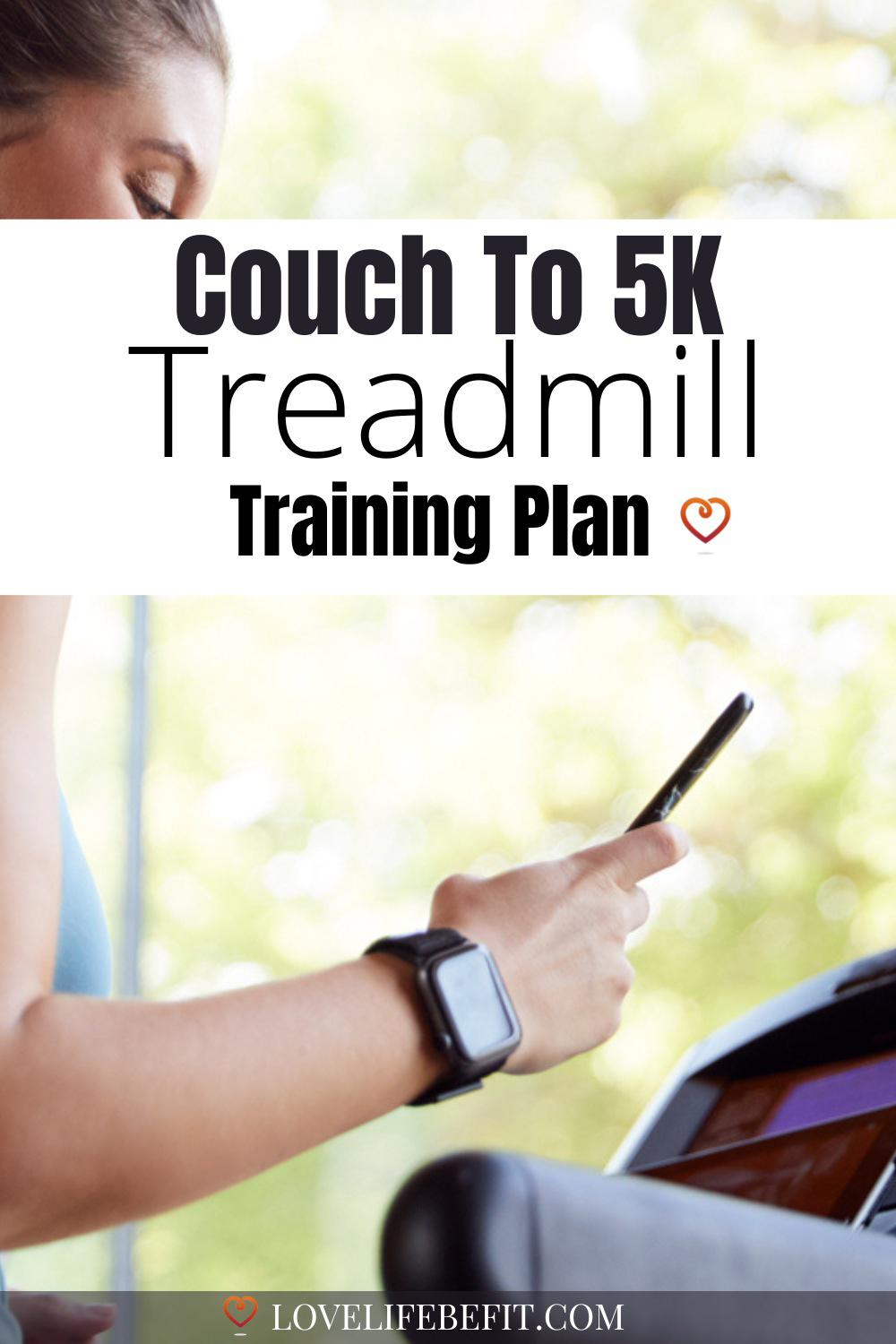
Does A 5K Running App Work With A Treadmill?
You can use your favorite couch to 5k running app with your treadmill or key in the training sessions provided below for different couch to 5k training plans.
Beginner Runners Couch To 5K Training Plans
Choosing a couch to 5k program should depend on your current level of fitness – not how many weeks you have until race day!
The most important thing for new runners is regular exercise and building weekly mileage slowly. The 9 and 6-week training plans include three rest days per week. Try and make some of these rest days an active day of rest where you walk with friends, swim, or cycle – move your body instead of sitting on the couch!
If you’re already fit from other sports and up for a challenge, try the 5-week 5k treadmill plan.
For new runners carrying a lot of excess weight, consider starting a walking for weight loss plan first.
It will be easier on your joints and you can do this walking for weight loss plan on a treadmill. You can always switch to running when you’ve lost some weight and got a bit fitter.
Couch To 5K Treadmill 6-Week Training Plan
A plan for new runners who have some fitness from other sports.
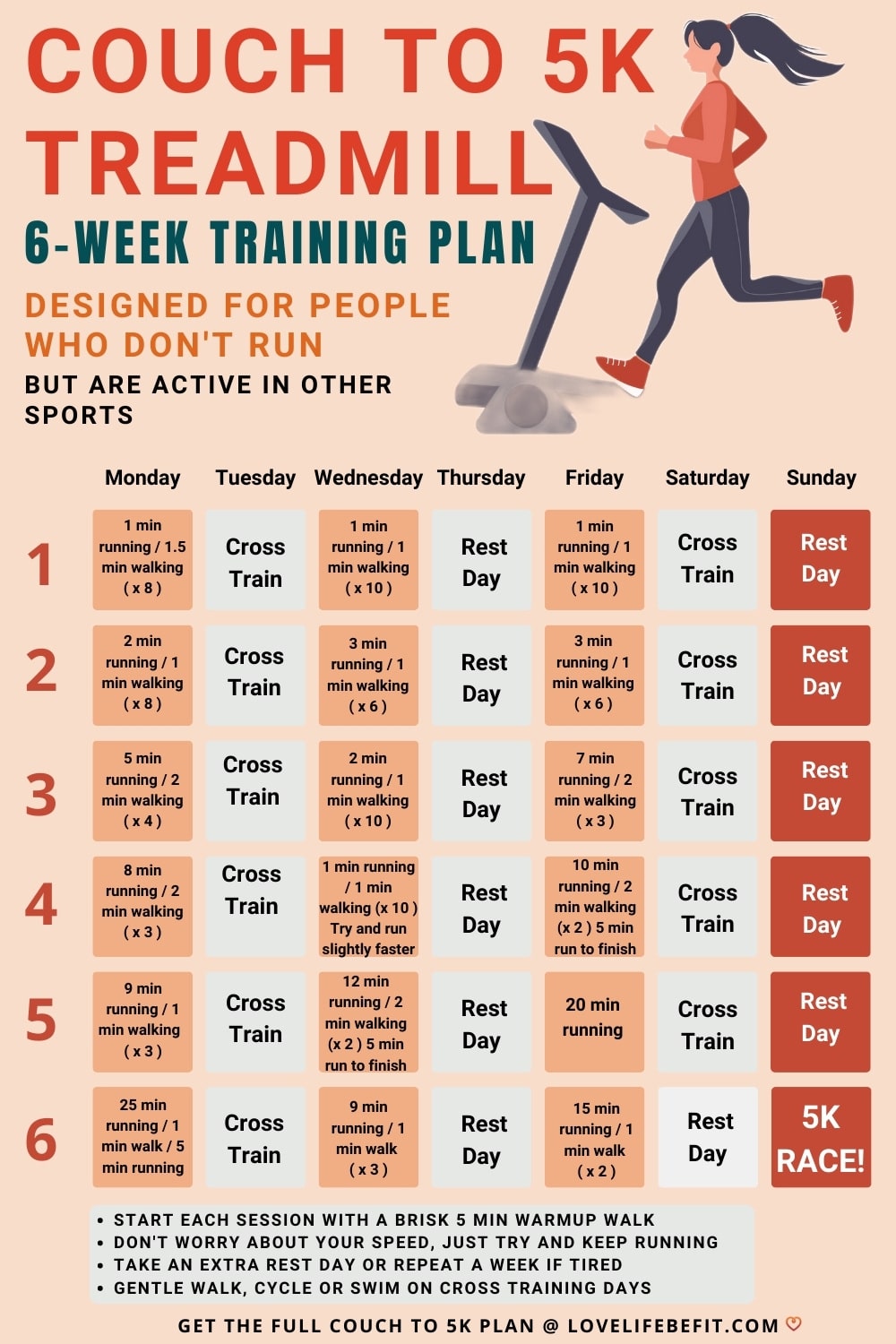
Couch To 5K 5-Week Training Plan
Already fit and up for a challenge? Try this 5-week plan…
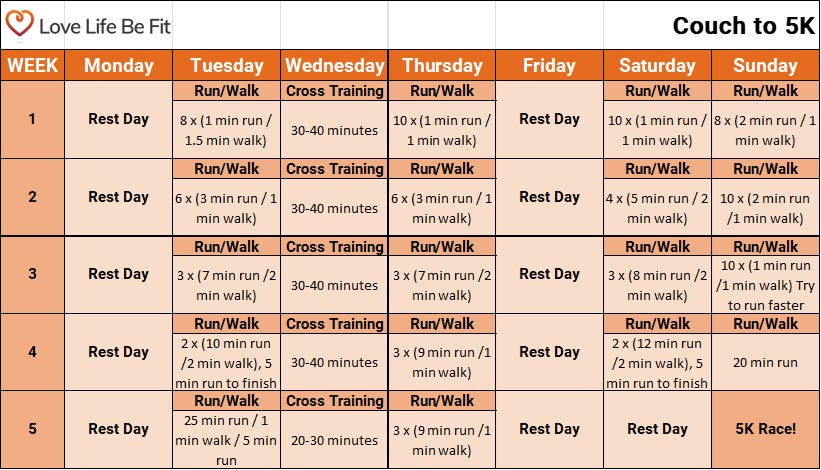
Related post: Couch To 5K Plan (It Doesn’t Work For Everyone) an in-depth guide and everything you need to know about Couch to 5K.
Running 101 Training Guides & Walking Schedules
5K Training Plans
- Couch To 5K Beginner Training Plan
- 12 Week 5K Training Plan
- 10 Week 5K Training Plan
- 8 Week 5K Training Plan
- 6 Week 5K Training Plan
- 4 Week 5K Training Plan
- 5K Training Plan Intermediate
